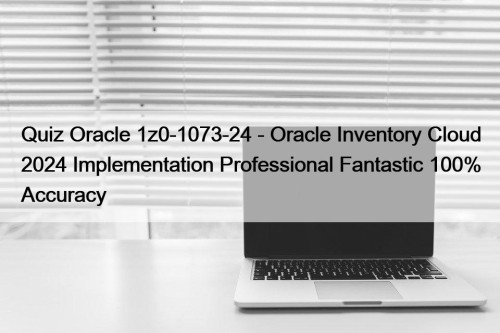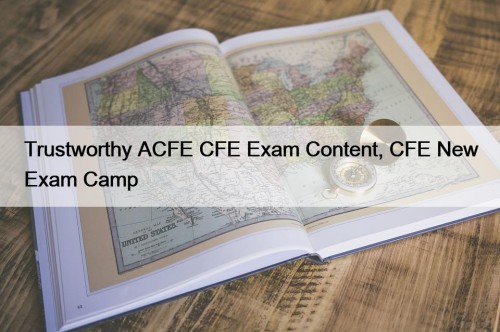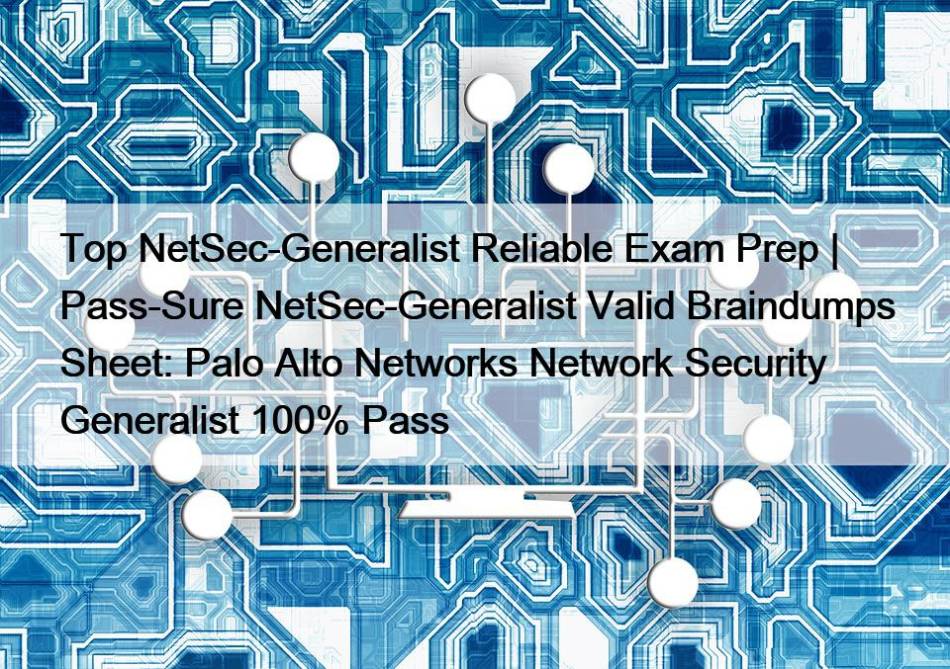Most Popular
 Quiz Oracle 1z0-1073-24 - Oracle Inventory Cloud 2024 Implementation Professional Fantastic 100% Accuracy
Quiz Oracle 1z0-1073-24 - Oracle Inventory Cloud 2024 Implementation Professional Fantastic 100% Accuracy
If you study with our 1z0-1073-24 exam questions, then you ...
 Trustworthy ACFE CFE Exam Content, CFE New Exam Camp
Trustworthy ACFE CFE Exam Content, CFE New Exam Camp
Once we have bought a practice materials, we may worry ...
 Efficient Latest PMI-ACP Braindumps Free Covers the Entire Syllabus of PMI-ACP
Efficient Latest PMI-ACP Braindumps Free Covers the Entire Syllabus of PMI-ACP
P.S. Free 2025 PMI PMI-ACP dumps are available on Google ...



Top NetSec-Generalist Reliable Exam Prep | Pass-Sure NetSec-Generalist Valid Braindumps Sheet: Palo Alto Networks Network Security Generalist 100% Pass

Thus you can study Palo Alto Networks NetSec-Generalist on your preferred smart device such as your smartphone or in hard copy format. Once downloaded from the website, you can easily study from the Palo Alto Networks NetSec-Generalist Exam Questions compiled by our highly experienced professionals as directed by the Palo Alto Networks exam syllabus.
Palo Alto Networks NetSec-Generalist Exam Syllabus Topics:
| Topic | Details |
|---|---|
| Topic 1 |
|
| Topic 2 |
|
| Topic 3 |
|
| Topic 4 |
|
>> NetSec-Generalist Reliable Exam Prep <<
NetSec-Generalist Valid Braindumps Sheet & NetSec-Generalist Valid Exam Preparation
The Lead2Passed wants to win the trust of Palo Alto Networks Network Security Generalist (NetSec-Generalist) certification exam candidates. To achieve this objective Lead2Passed is presenting Valid, Real, and Updated Palo Alto Networks Network Security Generalist (NetSec-Generalist) exam questions in three different formats. These formats have high demand in the market and offer the easiest and quick way for Palo Alto Networks Network Security Generalist (NetSec-Generalist) exam preparation.
Palo Alto Networks Network Security Generalist Sample Questions (Q12-Q17):
NEW QUESTION # 12
Which action is only taken during slow path in the NGFW policy?
- A. Security policy lookup
- B. Layer 2-Layer 4 firewall processing
- C. Session lookup
- D. SSUTLS decryption
Answer: D
Explanation:
In Palo Alto Networks Next-Generation Firewall (NGFW), packet processing is categorized into the fast path (also known as the accelerated path) and the slow path (also known as deep inspection processing). The slow path is responsible for handling operations that require deep content inspection and policy enforcement beyond standard Layer 2-4 packet forwarding.
Slow Path Processing and SSL/TLS Decryption
SSL/TLS decryption is performed only during the slow path because it involves computationally intensive tasks such as:
Intercepting encrypted traffic and performing man-in-the-middle (MITM) decryption.
Extracting the SSL handshake and certificate details for security inspection.
Inspecting decrypted payloads for threats, malicious content, and compliance with security policies.
Re-encrypting the traffic before forwarding it to the intended destination.
This process is critical in environments where encrypted threats can bypass traditional security inspection mechanisms. However, it significantly impacts firewall performance, making it a slow path action.
Other Answer Choices Analysis
(A) Session Lookup - This occurs in the fast path as part of session establishment before any deeper inspection. It checks whether an incoming packet belongs to an existing session.
(C) Layer 2-Layer 4 Firewall Processing - These are stateless or stateful filtering actions (e.g., access control, NAT, and basic connection tracking), handled in the fast path.
(D) Security Policy Lookup - This is also in the fast path, where the firewall determines whether to allow, deny, or perform further inspection based on the defined security policy rules.
Reference and Justification:
Firewall Deployment - SSL/TLS decryption is part of the firewall's deep packet inspection and Zero Trust enforcement strategies.
Security Policies - NGFWs use SSL decryption to enforce security policies, ensuring compliance and blocking encrypted threats.
VPN Configurations - SSL VPNs and IPsec VPNs also undergo decryption processing in specific security enforcement zones.
Threat Prevention - Palo Alto's Threat Prevention engine analyzes decrypted traffic for malware, C2 (Command-and-Control) connections, and exploit attempts.
WildFire - Inspects decrypted traffic for zero-day malware and sandboxing analysis.
Panorama - Provides centralized logging and policy enforcement for SSL decryption events.
Zero Trust Architectures - Decryption is a crucial Zero Trust principle, ensuring encrypted traffic is not blindly trusted.
Thus, SSL/TLS decryption is the correct answer as it is performed exclusively in the slow path of Palo Alto Networks NGFWs.
NEW QUESTION # 13
Which subscription sends non-file format-based traffic that matches Data Filtering Profile criteria to a cloud service to render a verdict?
Enterprise DLP
- A. Advanced WildFire
- B. Advanced URL Filtering
- C. SaaS Security Inline
Answer: C
NEW QUESTION # 14
Which action must a firewall administrator take to incorporate custom vulnerability signatures into current Security policies?
- A. Create custom policies.
- B. Download threat updates.
- C. Download WildFire updates.
- D. Create custom objects.
Answer: D
Explanation:
To incorporate custom vulnerability signatures into current Security policies, administrators must create custom objects. These objects define the specific signature patterns for vulnerabilities, and they can then be applied to security profiles or policies.
Custom Objects: Allow administrators to define and configure unique vulnerability signatures tailored to the organization's specific needs.
Integration into Security Policies: Once created, these custom objects can be referenced in Security policies to detect and mitigate the specified vulnerabilities effectively.
This approach ensures that custom threats not covered by default threat signatures are adequately addressed, enhancing the firewall's threat prevention capabilities.
Reference:
Custom Vulnerability Signatures in Palo Alto Networks
Threat Prevention Customization
NEW QUESTION # 15
A company uses Prisma Access to provide secure connectivity for mobile users to access its corporate-sanctioned Google Workspace and wants to block access to all unsanctioned Google Workspace environments.
What would an administrator configure in the snippet to achieve this goal?
- A. Dynamic Address Groups
- B. URL category
- C. Dynamic User Groups
- D. Tenant restrictions
Answer: D
Explanation:
A company using Prisma Access to secure Google Workspace access while blocking unsanctioned Google tenants must implement Tenant Restrictions.
Why are Tenant Restrictions the Right Choice?
Restricts Google Workspace Access to Approved Tenants
Tenant restrictions allow only authorized Google Workspace tenants (e.g., the company's official domain) and block access to personal or unauthorized instances.
Prevents Data Exfiltration & Shadow IT Risks
Without tenant restrictions, users could log into personal Google accounts and transfer corporate data to external environments.
Works with Prisma Access Security Policies
Prisma Access enforces tenant restrictions at the cloud level, ensuring compliance without requiring local device policies.
Other Answer Choices Analysis
(A) Dynamic Address Groups
Used to group IPs dynamically based on tags but does not control SaaS tenant access.
(C) Dynamic User Groups
Used for role-based access control (RBAC), not for restricting Google Workspace tenants.
(D) URL Category
Can filter web categories, but cannot differentiate between different Google Workspace tenants.
Reference and Justification:
Firewall Deployment & Security Policies - Tenant restrictions enforce Google Workspace access policies.
Threat Prevention & WildFire - Prevents data exfiltration via unauthorized Google accounts.
Zero Trust Architectures - Ensures only authorized cloud tenants are accessible.
Thus, Tenant Restrictions (B) is the correct answer, as it effectively blocks access to unsanctioned Google Workspace environments while allowing corporate-approved tenants.
NEW QUESTION # 16
What will collect device information when a user has authenticated and connected to a GlobalProtect gateway?
- A. RADIUS Authentication
- B. IP address
- C. Session ID
- D. Host information profile (HIP)
Answer: D
NEW QUESTION # 17
......
This Palo Alto Networks Network Security Generalist (NetSec-Generalist) practice exam software is easily accessible on all Windows laptops and computers. You do not require an active internet connection after installation of the Palo Alto Networks Network Security Generalist (NetSec-Generalist) practice exam software. Repetitive attempts of Palo Alto Networks Network Security Generalist (NetSec-Generalist) exam dumps boosts confidence and provide familiarity with the NetSec-Generalist actual exam format.
NetSec-Generalist Valid Braindumps Sheet: https://www.lead2passed.com/Palo-Alto-Networks/NetSec-Generalist-practice-exam-dumps.html
- NetSec-Generalist Testdump 🏚 NetSec-Generalist Valid Exam Pattern 🐕 NetSec-Generalist Useful Dumps 🦆 Go to website ▛ www.testkingpdf.com ▟ open and search for ➡ NetSec-Generalist ️⬅️ to download for free 🤕Valid NetSec-Generalist Test Materials
- Valid NetSec-Generalist Test Materials 👤 NetSec-Generalist Test Preparation 🤏 NetSec-Generalist Reliable Test Braindumps 🗜 Immediately open 《 www.pdfvce.com 》 and search for ➤ NetSec-Generalist ⮘ to obtain a free download ☎New NetSec-Generalist Study Guide
- Pass Guaranteed Useful Palo Alto Networks - NetSec-Generalist - Palo Alto Networks Network Security Generalist Reliable Exam Prep 🔍 Easily obtain [ NetSec-Generalist ] for free download through ➠ www.examcollectionpass.com 🠰 🧅New NetSec-Generalist Study Guide
- NetSec-Generalist Reliable Test Braindumps 🚎 NetSec-Generalist Testdump 🦑 NetSec-Generalist Reliable Test Braindumps 🦮 Open website ➥ www.pdfvce.com 🡄 and search for ☀ NetSec-Generalist ️☀️ for free download 🏁NetSec-Generalist Updated CBT
- NetSec-Generalist Valid Exam Labs ↖ NetSec-Generalist Updated CBT 👴 NetSec-Generalist Test Preparation 🌜 The page for free download of ⏩ NetSec-Generalist ⏪ on ☀ www.testkingpdf.com ️☀️ will open immediately 🕠New NetSec-Generalist Study Guide
- Pass Guaranteed High Hit-Rate NetSec-Generalist - Palo Alto Networks Network Security Generalist Reliable Exam Prep 🦨 Download ➤ NetSec-Generalist ⮘ for free by simply entering ⮆ www.pdfvce.com ⮄ website 🙀NetSec-Generalist Valid Exam Labs
- NetSec-Generalist Testdump 💋 NetSec-Generalist Updated CBT ❤️ Exam NetSec-Generalist Reference ✔️ Copy URL ➤ www.real4dumps.com ⮘ open and search for ⇛ NetSec-Generalist ⇚ to download for free 🏖Reliable NetSec-Generalist Learning Materials
- New NetSec-Generalist Study Guide 🚼 NetSec-Generalist Latest Test Preparation 🔙 NetSec-Generalist Testdump 🆚 Search for ( NetSec-Generalist ) and download exam materials for free through 「 www.pdfvce.com 」 🏠New NetSec-Generalist Study Guide
- Latest NetSec-Generalist Test Question 💳 NetSec-Generalist Valid Cram Materials 🎈 NetSec-Generalist Exam Pass Guide 😙 Easily obtain ▛ NetSec-Generalist ▟ for free download through ➥ www.lead1pass.com 🡄 🏆NetSec-Generalist Valid Cram Materials
- NetSec-Generalist Test Preparation 🆒 NetSec-Generalist Valid Cram Materials 🎊 NetSec-Generalist Valid Exam Pattern 🎺 Copy URL ☀ www.pdfvce.com ️☀️ open and search for ▛ NetSec-Generalist ▟ to download for free 🤖NetSec-Generalist Exam Answers
- Free PDF Marvelous Palo Alto Networks NetSec-Generalist Reliable Exam Prep 😙 “ www.torrentvalid.com ” is best website to obtain ➽ NetSec-Generalist 🢪 for free download 🧒NetSec-Generalist Testdump
- NetSec-Generalist Exam Questions
- qalinside.com easierandsofterway.com thevinegracecoach.com jackfox233.activosblog.com zeekuneeku.net americasexplorer.onegodian.org learning.aquaventurewhitetip.com funxatraininginstitute.africa sekolahbisnes.com tutor.shmuprojects.co.uk
Tags: NetSec-Generalist Reliable Exam Prep, NetSec-Generalist Valid Braindumps Sheet, NetSec-Generalist Valid Exam Preparation, Exam NetSec-Generalist Labs, NetSec-Generalist Accurate Test